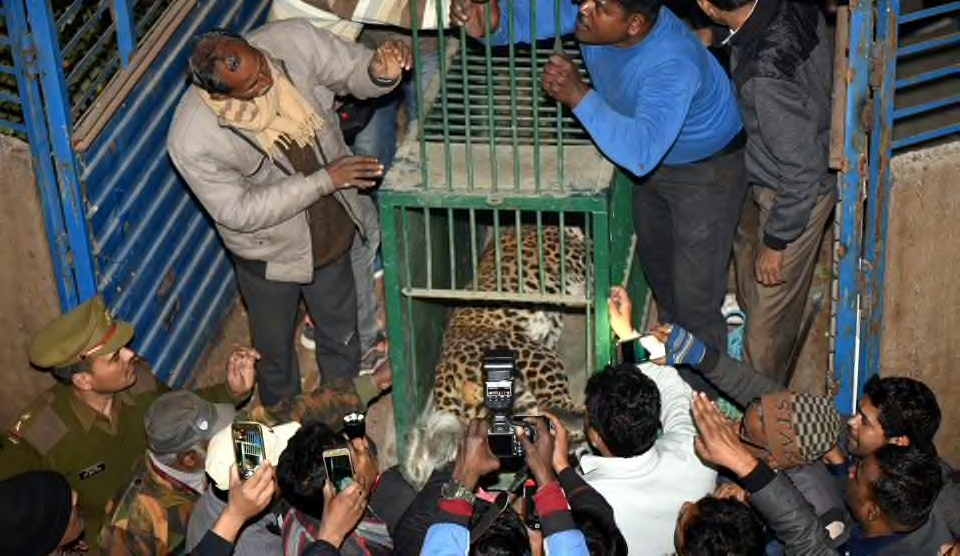- BY tictac
- POSTED IN Wildlife
- WITH 0 COMMENTS
- PERMALINK
- STANDARD POST TYPE

The leopard in India is struggling for survival. In the last 20 years, the natural forests of India have sharply diminished because of illegal encroachments, an enormous amount of illegal mining and agricultural conversions. Millions of livestock graze and degrade leopard habitat across this country and sharply reduce the availability of natural food. Blasted and battered in its natural habitat, the leopard has nowhere to go. Our nation has no vision or policy to protect the natural world. The politicians and bureaucrats have seldom thought or implemented a land use policy that could have kept wildlife safe. With 1.3 billion people desperate for land and natural resources, the leopard has been cornered. Many patches of remnant forest have little food for the leopard to eat. He is then forced closer to human habitation, starting a vicious cycle of man-leopard conflict. Around human populations, the leopard, now hungry and desperate, lives on stray dogs and small livestock. In daytime, the leopard finds a patch of trees or degraded wasteland to shelter in. It can vanish in such patch and remain invisible. As the sun sets, it moves towards human settlements to find food. Dogs are favoured. This is when it encounters man, and if detected, is chased, battered by sticks and stones and grievously injured or killed. To escape, it can race into a village hut or someone’s house. Then a forest team arrives and tranquilises it to take it either to a nearby forest where it is released or to a zoo where it ultimately dies. Huge errors are made in releasing leopards into forests especially if they are man-killers or man-eaters as in their struggling state they continue to attack man who has in their cycle of memory become their predator. Borivi in Maharashtra, Gir in Gujarat, Sariska in Rajasthan and dozens of other places across India have faced huge problems when problem leopards from miles away are released back in them. For those who govern such policies, ignorance is bliss. Such ignorant decisions have resulted in accelerating human and leopard deaths in many places. Into this menu of disasters, we engage private hunters. Even though we have over two lakh trained forest staff and all the technology in the world, we issue licences to trigger happy private hunters to eliminate problem leopards. And endless innocent animals are injured and killed in the process. The vicious cycle goes on.
Let’s look at the big picture. In my opinion, there must still be 15,000 to 18,000 leopards in India, if not more. At least, 1000 leopards are killed each year either by poaching or legal elimination or just battered to death by locals. Probably, another thousand are rescued or tranquilised and moved around to zoos and forests in the most chaotic and haphazard ways causing even more problems. Thousands of leopards haunt human settlements in an effort to feed on dogs or sheep and goats. Hundreds of humans are mauled, injured or killed each year. How on earth do we mitigate this conflict so that man and leopard can live more peacefully?
Firstly, we must accept the fact that leopards and people will live together right across India. There is no magic wand that will change this. Our only intervention is to make this relationship more peaceful so that the conflict between both is eased. There are more than 30 states and union territories that have to prioritise their interventions in order to do this. On my suggestion, the Rajasthan government started Project Leopard two years ago with a view to solve some of these problems. There are now eight designated Project Leopard reserves in Rajasthan including two around Udaipur and Jaipur with the primary mission of resolving conflict. Every state in India must start their Project Leopard areas to focus on this remarkable species.
There are some amazing examples to learn from, like the Jawai area in Rajasthan where tourism and conservation work hand in hand supported fully by local communities and without forest department’s interference. What the state governments must do is to create mobile rescue units, at least 1000 across India, to rush to the aid of both people and leopards in times of need. Science and good field research will play a critical role in making the work of these units effective and useful. Prompt compensation when leopards do damage will be essential in harmonising the relationship between the two.
Another vital strategy that must come into play with this new focus is the ability to restock some of our empty forest tracts with prey-food for the leopard. Doing this requires breeding farms for deer and outsourced to non governmental bodies. Australia breeds hundreds of thousands of Sambar deer. Surely, we can have our own breeding farms for spotted deer and so much more. The future lies in thinking out of the box and changing redundant policy.
State of the art protection is vital and finances can be raised by intelligent leopard tourism. Where there is a will there is a way. If such measures are not brought in the leopard in India is doomed to die.
Valmik Thapar has worked for 43 years with the big cats both in India and Africa and has written 34 books

